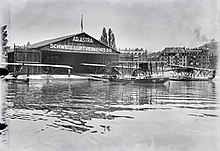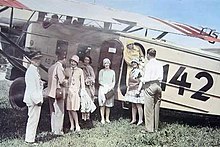Ad Astra Aero
| Ad Astra Aero | |
|---|---|
| IATA code : | (without) |
| ICAO code : | (without) |
| Call sign : | |
| Founding: | 1919 |
| Operation stopped: | 1931 |
| Merged with: | Swissair |
| Seat: |
Zurich , Switzerland |
| Fleet size: | |
| Aims: | |
| Ad Astra Aero merged with Swissair in 1931 . The information in italics relates to the last status before the takeover. | |
Ad Astra Aero (Latin for to fly to the stars ) was a Swiss airline .
Time of the pioneers



In 1919, the first of the various airlines that had formed commercially after the First World War were allowed to carry passengers. The transport of mail, mostly with old military machines, had turned out to be too little profitable in Switzerland. In April 1919, in Zurich , the Studer, Mittelholzerstrasse and Comte, Aero Company, Zurich entered in the Register, also known as Aero Society Comte Mittelholzerstrasse & Co. and renamed in November 1919 in Comte, Mittelholzerstrasse & Co. Aero Luftbildverlag institution and passenger flights . In October of the same year, Frick & Co took up air traffic, which was entered in the commercial register on September 26, 1919 as Frick and Co. Luftverkehrs-Gesellschaft Ad Astra . Rihner and Oskar Bider founded the Swiss Society for Air Tourism in July .
The merger of Frick and Aero-Gesellschaft led to the entry of the public limited company Ad Astra-Aero Schweizerische Luftverkehrs-AG, Zurich, in the Zurich commercial register on January 1, 1920 , the purpose of which was "Promotion of Swiss aviation, people and goods transport". Operations began on February 24, 1920. Alfred Comte was appointed chief pilot for land aircraft by the board of directors and Walter Mittelholzer was appointed head of the photo department. On April 21, 1920, Avion-Tourisme S.A. in Geneva was purchased and the share capital increased to CHF 600,000 . After this new merger, the company was renamed Ad Astra Aero, Avion Tourisme S. A. (Schweiz. Luftverkehrs A.-G.) . By 1921, however, the capital had already melted back to CHF 30,000. The hoped-for traffic from the Zurichhorn water airport never came about and even the sightseeing flights only generated losses. In the first two years of operation, aerial photography and air transport on demand were the main focus of operations, and in June 1922 the first scheduled flight from Geneva to Zurich to Fürth / Nuremberg took place. In the same year, the German Junkers plants took over 50 percent of the share capital. The driving forces behind the Ad Astra were the aviation pioneers Walter Mittelholzer and Alfred Comte. On behalf of Junkers , they flew to Berlin, Danzig and Riga. In the late summer of 1919 Comte and Mittelholzer took the Junkers F 13 flights over the Alps, Ticino, Matterhorn, and the Bernese Alps, and on September 11, 1919 they managed to fly over the 4810 meter high Mont Blanc . The co-managing director of Ad Astra, H. Pillichody, carried out the first Alpine passenger flight with the Junkers F 13 and five passengers in the Bernese Alps on July 18, 1921.
The two deaths in the company's history occurred on May 24, 1920, when the chief seaplane pilot, Taddeoli, and his mechanic had an accident on board a Savoia flying boat at an air show in Romanshorn . Financial problems limited flight operations in the first year of operation; The board of directors therefore recommended on December 23, 1920 that only pillichody, Max Cartier and Weber should be retained. Flight operations at the air stations limited Zurich and Geneva.
Flight routes
In a joint venture with Junkers Luftverkehr, the Fürth – Zurich – Geneva route was opened on June 1, 1921 and secured with four F 13s, and Ad Astra was the first airline in Switzerland to undertake regular international flights. The route was managed by F. Pillichody, who also carried out the first scheduled flight, and Gotthard Sachsenberg from Junkers; from September 1922 this extended the route to Berlin. In April 1924, the Zurich – Stuttgart – Frankfurt am Main air routes followed (operated by the Transeuropean Union), with a connection to the Berlin – Amsterdam route. The Ad-Astra route Geneva – Zurich – Munich received a new stopover in Lausanne in the same month. From May 15, 1924, Zurich – Munich – Vienna was added to the route network for passenger flights. In 1925, the Ad Astra had to separate its operations from that of the Trans-European Union, as the Swiss authorities did not pay any subsidies for an international company, and therefore limited operations to its main line Geneva – Zurich – Munich, exclusively with Swiss aircraft and pilots. However, it participated in the TREU or European Union and in 1926 was accepted into the International Air Traffic Association (the predecessor of the IATA ). The first serious accident in Swiss passenger air traffic occurred on June 14, 1928: An Ad Astra Junkers F 13 crashed after taking off from Niederrad / Frankfurt am Main; the pilot F. Chardon and three passengers were seriously injured.
Mittelholzers Africa flights
The Swiss media events of the 1920s were Walter Mittelholzer's Africa flights. The flights were mainly used for aerial photography and cartography . In 1926/27 he undertook the first transcontinental seaplane expedition from Zurich via Egypt to South Africa. In the winter of 1924/25 Mittelholzer flew to Tehran with great difficulty. The trip with two emergency landings lasted a month. His flights are considered to be the highest technical achievements for that time. In 1930, on another flight to Africa, Walter Mittelholzer was the first pilot to fly over Kilimanjaro .
fleet
The Junkers F 13 ( aircraft registration numbers CH-91, CH-92, CH-93 and CH-94) and Junkers G 23 were partially rented by Ad Astra. Smaller machines, some of which were decommissioned military aircraft, were used for mail and photo flights. From Zurich Horn (Zurich Seefeld ) also came Seaplanes the types Savoia and Macchi M.3 , Macchi M.9 and Macchi M.18 used. The aircraft types used later also included the two Dornier-Merkur high-wing B-Bal Merkur (CH-142/171), whereby these were equipped with floats for Mittelholzer's Africa flights, three Fokker F.VII (CH-190/192/193), a BFW / Messerschmitt M18 d (CH-191), at least one Comte AC-4 designed by Alfred Comte .
Merger with Balair to form Swissair
On December 31, 1930, in accordance with the retroactive resolution of the General Assembly of March 17, 1931, the airline was dissolved through a merger with Basler Luftverkehrs AG (Balair) . The merger was brought about by the Swiss Federal Aviation Authority, which otherwise threatened the two loss-making companies with subsidy cuts. Balair contributed around two thirds of the assets and share capital and provided 10 out of 14 members of the board of directors of the Swissair created by the merger . Walter Mittelholzer became its technical director.
See also
literature
- Benedikt Meyer: In flight. Swiss airlines and their passengers, 1919–2002. Chronos, Zurich 2014, ISBN 978-3-0340-1238-6 .
Web links
Individual evidence
- ↑ The airline Frick & Co., which was provisionally founded by Friedrich Rihner, Ernst Frick and Henry Pillichody, began air traffic on October 17, 1919.
- ↑ a b c d Chronicle of the use of the F 13 in Switzerland ( memento of March 2, 2012 in the Internet Archive ), accessed on December 13, 2008.
- ↑ Meyer, 2014, p. 30.
- ↑ Hans-Heiri Stapfer : The forgotten Zurichhorn seaplane base (2) - Modern swinging wings
- ↑ Meyer, 2014, p. 37.
- ^ Walter Mittelholzer: Kilimandjaro flight . Orell Füssli, Zurich 1930.
- ↑ Dornier Merkur with the matriculation number CH-142 bought Ad Astra on May 20, 1927 from Gren S. A .; it was taken over by Swissair on March 26, 1931 and scrapped in 1932. Walter Mittelholzer made his flights over the African continent with the Dornier Merkur CH-171. It was used by Ad Astra until March 26, 1931, went to Swissair with the merger and was scrapped in June 1932. German Aviation 1919–1945: Dornier Merkur , accessed on May 11, 2015.
- ↑ http://adastra-aero.com/4641.html (link not available)
- ^ Walter Mittelholzer - a Swiss aviation pioneer ( memento from March 5, 2016 in the Internet Archive ), accessed on December 13, 2008.
- ↑ Meyer, 2014, p. 38.
- ↑ Meyer, 2014, p. 38.

